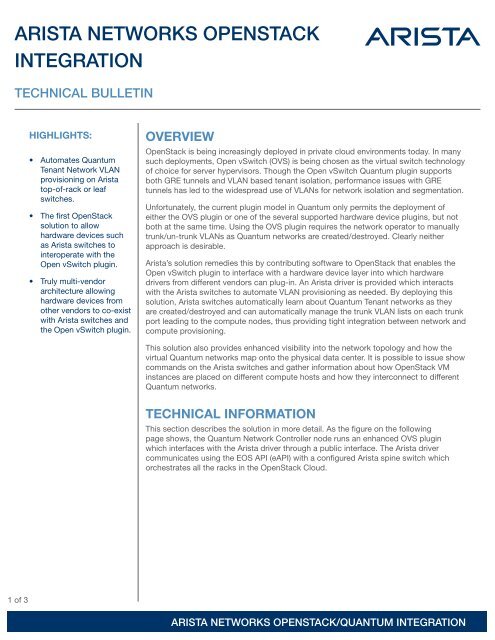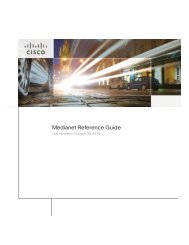ARISTA NETWORKS OPENSTACK INTEGRATION - BradReese.Com
ARISTA NETWORKS OPENSTACK INTEGRATION - BradReese.Com
ARISTA NETWORKS OPENSTACK INTEGRATION - BradReese.Com
You also want an ePaper? Increase the reach of your titles
YUMPU automatically turns print PDFs into web optimized ePapers that Google loves.
<strong>ARISTA</strong> <strong>NETWORKS</strong> <strong>OPENSTACK</strong><br />
<strong>INTEGRATION</strong><br />
TECHNICAL BULLETIN<br />
HIGHLIGHTS:<br />
• Automates Quantum<br />
Tenant Network VLAN<br />
provisioning on Arista<br />
top-of-rack or leaf<br />
switches.<br />
• The first OpenStack<br />
solution to allow<br />
hardware devices such<br />
as Arista switches to<br />
interoperate with the<br />
Open vSwitch plugin.<br />
• Truly multi-vendor<br />
architecture allowing<br />
hardware devices from<br />
other vendors to co-exist<br />
with Arista switches and<br />
the Open vSwitch plugin.<br />
OVERVIEW<br />
OpenStack is being increasingly deployed in private cloud environments today. In many<br />
such deployments, Open vSwitch (OVS) is being chosen as the virtual switch technology<br />
of choice for server hypervisors. Though the Open vSwitch Quantum plugin supports<br />
both GRE tunnels and VLAN based tenant isolation, performance issues with GRE<br />
tunnels has led to the widespread use of VLANs for network isolation and segmentation.<br />
Unfortunately, the current plugin model in Quantum only permits the deployment of<br />
either the OVS plugin or one of the several supported hardware device plugins, but not<br />
both at the same time. Using the OVS plugin requires the network operator to manually<br />
trunk/un-trunk VLANs as Quantum networks are created/destroyed. Clearly neither<br />
approach is desirable.<br />
Arista’s solution remedies this by contributing software to OpenStack that enables the<br />
Open vSwitch plugin to interface with a hardware device layer into which hardware<br />
drivers from different vendors can plug-in. An Arista driver is provided which interacts<br />
with the Arista switches to automate VLAN provisioning as needed. By deploying this<br />
solution, Arista switches automatically learn about Quantum Tenant networks as they<br />
are created/destroyed and can automatically manage the trunk VLAN lists on each trunk<br />
port leading to the compute nodes, thus providing tight integration between network and<br />
compute provisioning.<br />
This solution also provides enhanced visibility into the network topology and how the<br />
virtual Quantum networks map onto the physical data center. It is possible to issue show<br />
commands on the Arista switches and gather information about how OpenStack VM<br />
instances are placed on different compute hosts and how they interconnect to different<br />
Quantum networks.<br />
TECHNICAL INFORMATION<br />
This section describes the solution in more detail. As the figure on the following<br />
page shows, the Quantum Network Controller node runs an enhanced OVS plugin<br />
which interfaces with the Arista driver through a public interface. The Arista driver<br />
communicates using the EOS API (eAPI) with a configured Arista spine switch which<br />
orchestrates all the racks in the OpenStack Cloud.<br />
1 of 3<br />
<strong>ARISTA</strong> <strong>NETWORKS</strong> <strong>OPENSTACK</strong>/QUANTUM <strong>INTEGRATION</strong>
Quantum<br />
OVS Plugin<br />
Arista Driver<br />
eAPI<br />
Arista<br />
Core Switch<br />
Datacenter Leaf Layer<br />
TOR1 TOR1 TOR1<br />
Tenant 1<br />
Tenant 2<br />
Red VLAN<br />
Blue VLAN<br />
Ubuntu<br />
11<br />
Ubuntu<br />
45<br />
Ubuntu<br />
36<br />
Ubuntu<br />
23<br />
Ubuntu<br />
73<br />
Ubuntu<br />
61<br />
VM1 VM1 VM1 VM1<br />
The figure above shows two OpenStack tenant networks (Red Network and Blue<br />
Network) for which corresponding Quantum networks have been provisioned. The OVS<br />
plugin decides on the VLAN allocation for these tenant networks - Red VLAN and Blue<br />
VLAN above. These VLAN choices are conveyed by the OVS plugin to the Arista driver.<br />
The Arista driver in turn uses eAPI to communicate these VLANs to the Arista spine<br />
switch in addition to communicating to the compute host information about the<br />
particular VM that has been launched. By combining these pieces of information, the<br />
Arista spine switch is able to configure the trunk VLAN lists on the appropriate interfaces<br />
on the leaf switches (TOR1 above).<br />
The communication between the Arista spine switch and the leaf switches leverages<br />
the same distributed system technology that is used for sharing state within processes<br />
in EOS. As VM’s are terminated and relaunched on other compute nodes, or as new<br />
tenant networks are created, the Arista Quantum hardware driver keeps the spine switch<br />
updated, which in turn updates the trunk VLANs on appropriate interfaces.<br />
This architecture is also resilient with respect to hardware/software failures. If the spine<br />
switch were to be restarted, or the communication between the Quantum network<br />
controller and spine switch were to be briefly interrupted, the Arista Quantum hardware<br />
driver resyncs its state to the spine switch when a connection is reestablished. If the leaf<br />
switches were to be restarted, the spine switch automatically reprograms the trunk lists<br />
on them when they come back online.<br />
HARDWARE DRIVER API<br />
We have added the following API between the OVS plugin and hardware device drivers.<br />
When the OVS plugin is loaded, it will load one or more hardware device drivers (based<br />
on configuration) and invoke the following API when tenant networks are created, VM’s<br />
are launched, etc.<br />
2 of 3<br />
<strong>ARISTA</strong> <strong>NETWORKS</strong> <strong>OPENSTACK</strong>/QUANTUM <strong>INTEGRATION</strong>
• create_network(network_id)<br />
Configures an L2 isolated network on the vendor hardware for given tenant<br />
using the configured segmentation_type.<br />
• plug_host(network_id, segmentation_id, host_id)<br />
Adds a host to the network.<br />
• unplug_host(network_id, segmentation_id, host_id)<br />
Removes a host from the network.<br />
• delete_network(network_id)<br />
Removes the previously provisioned network segmentation from the<br />
switches<br />
The Arista driver implementing this interface will be provided with the OpenStack<br />
Quantum distribution. The API is open and allows other hardware device vendors to<br />
implement similar drivers to create a multi-vendor solution. Arista has open-sourced the<br />
driver and the entire framework back to the OpenStack community.<br />
Arista is currently in the process of getting this API standardized and pushed into the<br />
Havana release of OpenStack. However the Arista solution will be available from our<br />
website for early adopters and should be usable with OpenStack Folsom/Grizzly.<br />
CONCLUSION<br />
The Arista OpenStack solution automates the provisioning of VLANs on Arista switches<br />
to work in concert with the OVS plugin. This is in contrast to the other OpenStack plugins<br />
available today, which allow deployment of either the virtual switch plugin or the hardware<br />
device plugin, but not both. The architecture implemented is open and vendor agnostic.<br />
Providing this capability within the OpenStack solution is a significant achievement<br />
for integration with physical network devices. The availability of the drivers published<br />
back into the OpenStack community by Arista Networks can lead to truly multi-vendor<br />
solutions for VLAN provisioning automation within OpenStack environments.<br />
Santa Clara — Corporate<br />
Headquarters<br />
5470 Great America Parkway<br />
Santa Clara, CA 95054<br />
Phone: 408-547-5500<br />
Fax: 408-538-8920<br />
Email: info@aristanetworks.com<br />
San Francisco — R&D and Sales Office<br />
1390 Market Street<br />
Suite 800<br />
San Francisco, CA 94102<br />
India — R&D Office<br />
Eastland Citadel<br />
102, 2nd Floor, Hosur Road<br />
Madiwala Check Post<br />
Bangalore - 560 095<br />
Vancouver — R&D Office<br />
Suite 350, 3505 Gilmore Wayt<br />
Burnaby, British Columbia<br />
Canada V5G 4X5<br />
Ireland — International Headquarters<br />
Hartnett Enterprise Acceleration Moylish Park<br />
Limerick, Ireland<br />
Singapore — APAC<br />
Administrative Office<br />
9 Temasek Boulevard<br />
29-01, Suntec Tower Two<br />
Singapore 038989<br />
3 of 3<br />
All rights reserved. This product is protected by U.S. and international copyright and intellectual property laws.<br />
VMware products are covered by one or more patents listed at http://www.vmware.com/go/patents. VMware<br />
is a registered trademark or trademark of VMware, Inc. in the United States and/or other jurisdictions. All other<br />
marks and names mentioned herein may be trademarks of their respective companies.<br />
© Copyright 2013 Arista Networks, Inc.<br />
Information contained herein is subject to change without notice. Arista and the Arista logo are trademarks of<br />
Arista Networks Inc .<br />
<strong>ARISTA</strong> <strong>NETWORKS</strong> <strong>OPENSTACK</strong>/QUANTUM <strong>INTEGRATION</strong>







